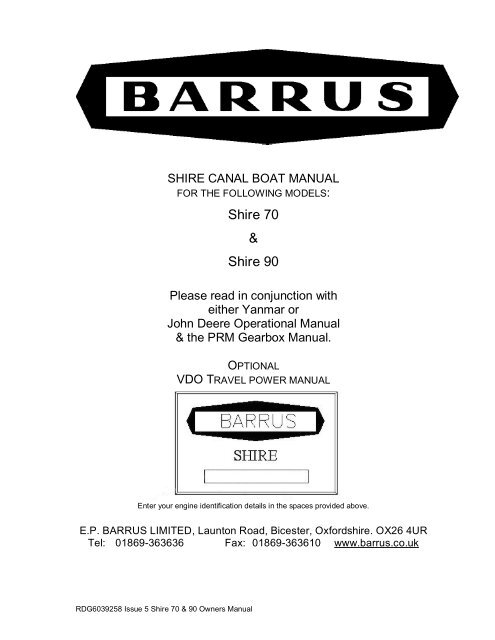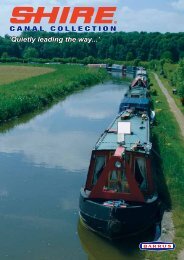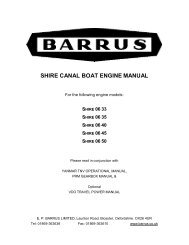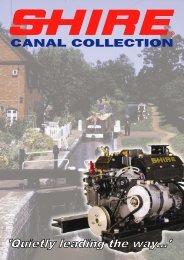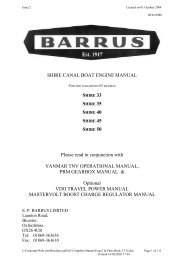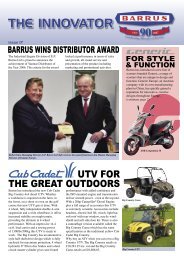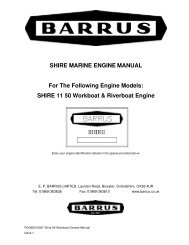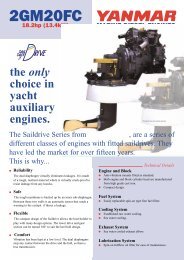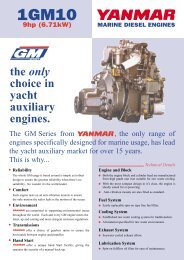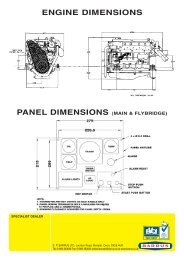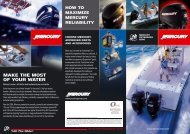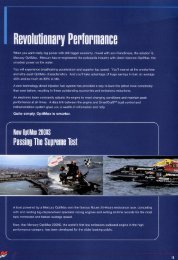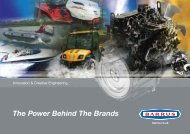Shire Owners' Manual (11 Build) 70 & 90 (PDF) - EP Barrus
Shire Owners' Manual (11 Build) 70 & 90 (PDF) - EP Barrus
Shire Owners' Manual (11 Build) 70 & 90 (PDF) - EP Barrus
Create successful ePaper yourself
Turn your PDF publications into a flip-book with our unique Google optimized e-Paper software.
SHIRE CANAL BOAT MANUALFOR THE FOLLOWING MODELS:<strong>Shire</strong> <strong>70</strong>&<strong>Shire</strong> <strong>90</strong>Please read in conjunction witheither Yanmar orJohn Deere Operational <strong>Manual</strong>& the PRM Gearbox <strong>Manual</strong>.OPTIONALVDO TRAVEL POWER MANUALEnter your engine identification details in the spaces provided above.E.P. BARRUS LIMITED, Launton Road, Bicester, Oxfordshire. OX26 4URTel: 01869-363636 Fax: 01869-363610 www.barrus.co.ukRDG6039258 Issue 5 <strong>Shire</strong> <strong>70</strong> & <strong>90</strong> Owners <strong>Manual</strong>
Declaration of Conformity for Recreational Craft PropulsionEngine with the requirements of Directive 94/25/EC as amendedby 2003/44/EC.Name of Engine Manufacturer: Yanmar Co Ltd.Address: Yanmar Europe B.V, Brugplein <strong>11</strong>, 1332 BS Almere-de Vaart, Netherlands.Name of Authorised Representative: E.P.<strong>Barrus</strong> LtdAddress: E.P.<strong>Barrus</strong> Ltd, Launton Road, Bicester, Oxon, OX26 4UR, EnglandEngine type approved according to: Stage II of Directive 97/68/EC,88/77/ECDescription of Engine(s) and Essential RequirementsEngine Type: Inboard EngineFuel Type: DieselCombustion Cycle: 4 StrokeIdentification of Engine(s) covered by this Declaration of ConformityEngine Model Engine Type Engine Family code Type Approval Certificate Number<strong>Shire</strong> 40/45/50 4 TNV 88 DSA 5YDXL2.19K4N e13*97/68DA*2001/63*0574*06<strong>Shire</strong> <strong>70</strong> 4 TNV 98 NSA YD3300DNMGEC e13*97/68GA*2001/63*0545*<strong>11</strong>Essential RequirementsStandardsOther normativedocument/method.TechnicalfileAnnex 1.B- Exhaust EmissionsB.1 Engine Identification B.2 Exhaust emissionSpecify in more detail*= Mandatory standard.* * EN ISO 8178- 1:1996requirementsB.3 Durability B.4 Owners <strong>Manual</strong> Annex 1. C- Noise Emissions See Declaration of Conformity of the craft in which the engine(s) has(have) been installedThis declaration of conformity is issued under the sole responsibility of the manufacturer. I declare onbehalf of the engine manufacturer that the engine(s) [is (are) in conformity with the type(s) for whichabove mentioned EC type-examination or type approval certificate(s) has (have) been issued and] 1 willmeet the exhaust emission requirements of Directive 94/25/EC as amended by Directive 2003/44/ECwhen installed in a recreational craft, in accordance with the engine manufacturer’s supplied instructionsand that this (these) engine(s) must not be put into service until the recreational craft which it is (they are)to be installed has been declared in conformity with the relevant provisions of the above mentionedDirectives.Tim HartSales DirectorSigned: Bicester, UKRDG6039258 Issue 5 <strong>Shire</strong> <strong>70</strong> & <strong>90</strong> Owners <strong>Manual</strong> Page 2 of 48
Declaration of Conformity for Recreational Craft PropulsionEngine with the requirements of Directive 94/25/EC as amendedby 2003/44/EC.Name of Engine Manufacturer: John Deere Power SystemsAddress: Usine de Saran, B.P. <strong>11</strong>013, 45401 Fleury-les-Aubrais Cedex, FranceName of Authorised Representative: E.P.<strong>Barrus</strong> LtdAddress: E.P.<strong>Barrus</strong> Ltd, Launton Road, Bicester, Oxon, OX26 4UR, EnglandEngine type approved according to: Stage II of Directive 97/68/EC,88/77/ECDescription of Engine(s) and Essential RequirementsEngine Type: Inboard EngineFuel Type: DieselCombustion Cycle: 4 StrokeIdentification of Engine(s) covered by this Declaration of ConformityEngine Model Engine Type Engine Family code Type Approval Certificate Number<strong>Shire</strong> <strong>90</strong> 4045DF2<strong>70</strong>B 5JDXL04.5076 e<strong>11</strong>*97/68GA*2002/88*0219*00Essential Requirements Standards Other normativedocument/method.TechnicalfileSpecify in more detail*= Mandatory standard.Annex 1.B- Exhaust EmissionsB.1 Engine Identification B.2 Exhaust emission* * EN ISO 8178- 1:1996requirementsB.3 Durability B.4 Owners <strong>Manual</strong> Annex 1. C- Noise Emissions See Declaration of Conformity of the craft in which the engine(s) has(have) been installedThis declaration of conformity is issued under the sole responsibility of the manufacturer. I declare onbehalf of the engine manufacturer that the engine(s) [is (are) in conformity with the type(s) for whichabove mentioned EC type-examination or type approval certificate(s) has (have) been issued and] 1 willmeet the exhaust emission requirements of Directive 94/25/EC as amended by Directive 2003/44/ECwhen installed in a recreational craft, in accordance with the engine manufacturer’s supplied instructionsand that this (these) engine(s) must not be put into service until the recreational craft which it is (they are)to be installed has been declared in conformity with the relevant provisions of the above mentionedDirectives.Tim HartSales DirectorSigned: Bicester, UKRDG6039258 Issue 5 <strong>Shire</strong> <strong>70</strong> & <strong>90</strong> Owners <strong>Manual</strong> Page 3 of 48
PLEASE NOTE:This manual has been compiled to help you to operate your engine and its associatedparts with safety and pleasure. Please read it carefully and familiarise yourself with theengine and its parts before operation.E.P.<strong>Barrus</strong> reserve the right to change the specification of its products and manualswithout prior notice.Depending upon the equipment specification of the engine and accessories fitted, theremay be discrepancies with the information presented in this handbook. No claims maybe pursued in this respect.WARNING:THIS MANUAL FORMS AN INTEGRAL PART OF THE ENGINE IT ACCOMPANIES, IFA TRANSFER OF TITLE OCCURS, IT MUST ALWAYS BE HANDED OVER TO THENEW OWNER.WARRANTYThis Limited Warranty provides coverage for five (5) years (or 2000 hours which everoccurs first) for recreational users and three (3) years (or 2000 hours which ever occursfirst) for commercial users from the date of warranty registration. The repair orreplacement of parts, or the performance of service under this warranty, does notextend the life of this warranty beyond its original expiry date.PRM 260 gearboxes are covered by a three (3) year warranty for recreational users andtwo (2) years for commercial users.To ensure that you have been registered for your warranty, please ask your Boat-<strong>Build</strong>er or Engine supplier to provide your portion of the registration form.Engine alternator, starter motor and electrical components are only covered by a one(1) year warranty.RDG6039258 Issue 5 <strong>Shire</strong> <strong>70</strong> & <strong>90</strong> Owners <strong>Manual</strong> Page 4 of 48
CONDITIONS THAT MUST BE MET IN ORDER TO OBTAIN WARRANTYCOVERAGEWarranty coverage is only available from an authorised dealer in the country in whichthe sale occurred. Routine maintenance outlined in the Owners <strong>Manual</strong> must beperformed using genuine parts in order to maintain warranty coverage. If the customerperforms maintenance, <strong>Barrus</strong> reserves the right to make future warranty coveragepossible only with proof of proper maintenance.WARRANTY CLAIMSWarranty claims shall be made by an authorised dealer or boat builder.The dealer or boat builder will then arrange for the inspection and any necessaryrepairs. If the repairs carried out are not covered by the warranty, purchaser shall payfor all related labour and material, and any other expenses associated with that service.WHAT IS NOT COVEREDThis limited warranty does not cover routine maintenance items, adjustments, normalwear and tear, damage caused by abnormal use, operation of the product in a mannerinconsistent with the recommended operation/duty cycle section of the Owners <strong>Manual</strong>,accident, submersion, improper installation (proper installation specification andtechniques are set forth in the Operations and First time running sections in thismanual), use of an accessory or part not manufactured or sold by us, or alteration orremoval of parts. Expenses related to crane-out, launch, towing, storage, telephone,rental, inconvenience, slip fees, insurance coverage, loan payments, loss of time, lossof income, or any other types of accidental or consequential damages are not coveredby this warranty.Failure to use John Deere approved oils and coolants will invalidate any warranty (<strong>Shire</strong><strong>90</strong>).Engine electrical systems fitted with alternator boost charge systems or any otherelectrical management systems other than those approved by <strong>Barrus</strong> are not coveredby warranty.RDG6039258 Issue 5 <strong>Shire</strong> <strong>70</strong> & <strong>90</strong> Owners <strong>Manual</strong> Page 5 of 48
IndexSECTION 1 - SAFETY PRECAUTIONS.........................................................................81. General...............................................................................................................................................82. Lifting..................................................................................................................................................83. Rotating Shafts and Belts.....................................................................................................................84. Exhaust System....................................................................................................................................85. Launching and Lifting Boats................................................................................................................86. Batteries..............................................................................................................................................8SECTION 2 - ENGINE IDENTIFICATION.....................................................................10SECTION 3 - INSTALLATION......................................................................................<strong>11</strong>1. Ventilation.............................................................................................................................................<strong>11</strong>2. Engine Beds..........................................................................................................................................<strong>11</strong>3. Cooling System......................................................................................................................................<strong>11</strong>4. Skin Tanks.............................................................................................................................................<strong>11</strong>5. Pressurised Water Header Tank............................................................................................................126. Shaft Connection...................................................................................................................................137. Engine Anti-Vibration Mounts...............................................................................................................148. Engine Mount Installation.....................................................................................................................149. Engine Alignment..................................................................................................................................1610. Electrics............................................................................................................................................17<strong>11</strong>. Electrical Options..............................................................................................................................1812. Engine Oil.........................................................................................................................................1813. Fuel...................................................................................................................................................1814. Coolant.............................................................................................................................................1915. Calorifier ..........................................................................................................................................1916. Control Cables..................................................................................................................................2017. Domestic Battery Bank.......................................................................................................................2018. Control Panel....................................................................................................................................21SECTION 4 - OPERATION...........................................................................................221. Starting The Engine For The First Time.................................................................................................222. Starting Procedure................................................................................................................................223. Stopping Procedure...............................................................................................................................234. Full Load Running.................................................................................................................................235. Refuelling..............................................................................................................................................236. Diesel Fuel Additive..............................................................................................................................237. Twin Thermostats..................................................................................................................................238. Exhaust Back Pressure ....................................................................................................................24SECTION 5 - SERVICE PROCEDURE........................................................................251. Engine Oil and Filter Change................................................................................................................252. Air Filter Check & Change....................................................................................................................263. Gearbox Oil Change..............................................................................................................................264. Disposal of Oil and Related Items..........................................................................................................275. Primary Fuel Filter Water Drain...........................................................................................................276. Primary Fuel Filter Change (<strong>Shire</strong> <strong>70</strong>)..................................................................................................287. Primary Fuel Filter Change (<strong>Shire</strong> <strong>90</strong>)..................................................................................................288. Secondary Fuel Filter Change...............................................................................................................289. Fuel System Bleeding.............................................................................................................................2910. Cooling System..................................................................................................................................29<strong>11</strong>. Belt Adjustment..................................................................................................................................3012. Belt Maintenance...............................................................................................................................3013. Belt Replacement...............................................................................................................................3014. Deluxe Panel Maintenance................................................................................................................32SECTION 6 - SERVICE PARTS...................................................................................33SECTION 7 - SERVICE SCHEDULE ...........................................................................34RDG6039258 Issue 5 <strong>Shire</strong> <strong>70</strong> & <strong>90</strong> Owners <strong>Manual</strong> Page 6 of 48
SECTION 8 - WIRING DIAGRAMS..............................................................................351. Engine Wiring Diagram <strong>Shire</strong> <strong>70</strong>...........................................................................................................352. Engine Wiring Diagram, <strong>Shire</strong> <strong>90</strong> (12 Volt)...........................................................................................363. Engine Wiring Diagram, <strong>Shire</strong> <strong>90</strong> (24 Volt)...........................................................................................374. Deluxe Panel Wiring Diagram (12 volt).................................................................................................385. Deluxe Panel Wiring Diagram (24 volt).................................................................................................396. VDO 7KW Wiring diagram and overall dimensions................................................................................417. 5kW VDO Travel Power System.............................................................................................................42SECTION 9 - GENERAL ARRANGEMENT DRAWINGS............................................431. <strong>Shire</strong> <strong>11</strong> <strong>70</strong>........................................................................................................................................432. <strong>Shire</strong> <strong>11</strong> <strong>70</strong> Bobtail (no gearbox) .......................................................................................................443. <strong>Shire</strong> <strong>11</strong> <strong>90</strong>........................................................................................................................................454. <strong>Shire</strong> <strong>11</strong> <strong>90</strong> Bobtail (no gearbox) .......................................................................................................46SECTION 10 - DEALER LIST......................................................................................47SECTION <strong>11</strong> – SERVICE RECORD CARD..................................................................48RDG6039258 Issue 5 <strong>Shire</strong> <strong>70</strong> & <strong>90</strong> Owners <strong>Manual</strong> Page 7 of 48
SECTION 1 - Safety Precautions1. GeneralIt is the responsibility of the installer/operator to ensure that the finished installationcomplies with the relevant health & safety requirements and the recreational craftdirective before commissioning.Ensure that the engine battery isolator switch is in the off position and the key removedfrom the control panel before carrying out any maintenance or repairs.2. LiftingThe lifting points supplied with the engine are for lifting the engine/gearbox only. Asuitable spreader bar must be employed to prevent over-stressing either bracket duringany lift.3. Rotating Shafts and BeltsThe engine and its accessories are not intended to be put into operation until it isintegrated into the boat as a whole. No person should be in the engine compartmentwhilst the engine is running.4. Exhaust SystemExhaust gases may have temperatures as high as 650 o c and contain elements whichare harmful if ingested. It is therefore essential that exhaust systems are gas tight andlagged to prevent accidental burning.5. Launching and Lifting BoatsCare must be taken when launching or craning new boats into or out of the waterway,so that water does not enter the engine via the exhaust system or air vents. It isrecommended that these are blocked temporarily whilst undertaking this procedure.6. BatteriesWARNING:EXPLOSIVE GASES / SULPHURIC ACID• Batteries can produce explosive gases, keep sparks and flames away from thebattery. NO SMOKING.• Batteries contain sulphuric acid; if splashed on skin or eyes, flush well with waterand seek medical advice.• Keep the battery tops and battery compartment ventilated at all times.• If disconnecting the battery; remove the earth lead FIRST; and re-connect it last.RDG6039258 Issue 5 <strong>Shire</strong> <strong>70</strong> & <strong>90</strong> Owners <strong>Manual</strong> Page 8 of 48
• If charging the battery; ensure that the charger is switched off before connecting anddisconnecting.• Do not tip the battery on its side.• Please see label on battery or manufacturers instructions for specific information.RDG6039258 Issue 5 <strong>Shire</strong> <strong>70</strong> & <strong>90</strong> Owners <strong>Manual</strong> Page 9 of 48
SECTION 2 - Engine IdentificationPlease quote the engine identification number during any enquiry or when orderingspare parts.This is found engraved into the brass plate, on top of the engine rocker cover andstamped to the crankcase above the starter motor.An example of the engine identification plate is as follows:Figure 2-1: Engine Identification BadgeNote: There are a number of optional extras that may be fitted to an engine for particularcustomer’s engine that are not listed here.A list of common item service part numbers can be found in <strong>Shire</strong> service parts, inSection 6.RDG6039258 Issue 5 <strong>Shire</strong> <strong>70</strong> & <strong>90</strong> Owners <strong>Manual</strong> Page 10 of 48
SECTION 3 - Installation1. Ventilation• All internal combustion engines radiate heat and require cool, clean air for completecombustion purposes.• Please ensure that adequate engine room ventilation is provided, by fitting at leasttwo vents of an aperture of not less than 15,000 mm 2 each, (24 in 2 ).An allowance must be made for any grills or louvres placed in the airflows andgenerally, an increase of 25% in area is sufficient to overcome any restrictionproblems.2. Engine Beds• These should be a minimum of 10mm thick and extended rearward and be weldedto the hull and forward to the bulkhead. There must be webs or gussets welded inplace to prevent flexing.3. Cooling System• Ensure pipe work to and from the skin tanks is of sufficient bore. A minimum of45mm (1½") is recommended. Ensure tight bends and elbows are avoided or kept toa minimum.4. Skin Tanks• The ideal skin tank internal thickness should be not less than 50mm and not exceed75mm; the table below will indicate a suitable size however volume will notcompensate for lack of surface area. It should be recognised that fitting a largecalorifier would increase the theoretical cooling capacity only until it is up totemperature. It is unlikely that a boat on the inland waterways will operate at fullpower for more than short periods. The engine cooling water outlets are on the righthand (starboard) side of the engine.RDG6039258 Issue 5 <strong>Shire</strong> <strong>70</strong> & <strong>90</strong> Owners <strong>Manual</strong> Page <strong>11</strong> of 48
Air Bleed PointsCoolant fromEngineHeightCoolant toEngineLengthFigure 3-1: Skin Tank Flow DiagramRecommended Skin Tank SizeSkin tank Surface Suggested Suggested LengthEngine HP KWarea m 2 Height mm mm<strong>90</strong> <strong>90</strong> 67 2.15 952 2258<strong>70</strong> <strong>70</strong> 51.7 1.55 840 18505. Pressurised Water Header Tank• The pressurised water bottle should be mounted higher than the level of the engineand no more than 1 metre from the engine. This will prevent cooling system airlocks.• The header tank has two hose connections of different internal diameters.• <strong>Shire</strong> <strong>70</strong> - The smaller internal diameter hose tail (left side of tank) should beconnected to the top of the twin thermostat housing on the engine. This is the airbleed.The larger internal diameter hose-tail (right side of tank) should be connectedto the lower pipe on the engine. This is the water-fill.RDG6039258 Issue 5 <strong>Shire</strong> <strong>70</strong> & <strong>90</strong> Owners <strong>Manual</strong> Page 12 of 48
Figure 3-2: <strong>Shire</strong> <strong>70</strong> Header Tank Connections• <strong>Shire</strong> <strong>90</strong> - The smaller internal diameter hose tail (left side of tank) should beconnected to the top of the engine. This is the air-bleed. The larger internal diameterhose-tail (right side of tank) should be connected to the lower pipe on the engine(circled left). This is the water-fill.Figure 3-3: <strong>Shire</strong> <strong>90</strong> Header Tank Connections6. Shaft Connection• Some type of flexible coupling must be used to connect the gearbox output flange tothe propeller shaft flange.RDG6039258 Issue 5 <strong>Shire</strong> <strong>70</strong> & <strong>90</strong> Owners <strong>Manual</strong> Page 13 of 48
7. Engine Anti-Vibration Mounts• Ensure that the engine feet do not end up at the top of the thread on the enginemounts, this puts undue pressure on them and can result in excessive enginemovement and premature mount failure. Mount the engine using the steel packingplates supplied under the engine mounts RDG3<strong>90</strong>6, see general arrangementdrawings from page 41.• Ensure that the engine has been installed for at least 24 hours before shaftalignment is checked, this allows the mounts time to settle under the engine weight.• Ensure that the anti-vibration mount centre screw is sufficiently raised so as not totouch the engine bed. If this occurs excessive engine vibration will be experiencedthrough the hull.• For best results, fit the front anti vibration mounts into the front holes in the enginerails. If engine room space is a problem the mounts can be fitted slightly further backin alternative holes, and the front of the rail cut off – leaving 50mm of material toretain strength (measuring from the centre of the mount hole to the front end of therail). Note: this procedure is only possible on non VDO travel power engines, andmay result in a very slight increase in vibration.• The anti vibration mounts have a small number stamped in to them, a <strong>Shire</strong> 06 <strong>70</strong>has 45 and <strong>Shire</strong>06 <strong>90</strong> has 55.8. Engine Mount InstallationFigure 3-4: Correct Anti-Vibration Mount Installation• Care should taken to install mounts parallel to the engine rails with the washer andlocknut firmly tightened on the cover of the mount. The maximum distance from thetop of the locknut to the base of the adjusting nut must not exceed 5mm; any greateradjustment should be made using shims.RDG6039258 Issue 5 <strong>Shire</strong> <strong>70</strong> & <strong>90</strong> Owners <strong>Manual</strong> Page 14 of 48
Figure 3-5: Correct Anti-Vibration Mount InstallationRDG6039258 Issue 5 <strong>Shire</strong> <strong>70</strong> & <strong>90</strong> Owners <strong>Manual</strong> Page 15 of 48
Alternative mounting position ifengine compartment space isrestricted.Normal mounting position.Figure 3-6: Anti-Vibration Mount Installation Points9. Engine Alignment• The gearbox output shaft flange and propeller shaft input flange must be almostperfectly aligned. A maximum of 0.05mm (0.002") misalignment in any plane isacceptable. Ensure alignment is rechecked after the first 4 hours of running, at theend of the first month and annually thereafter.• If the engine is out of alignment it will result in excessive vibration and possibledamage to the stern tube and propeller shaft.• Boats that are fitted with fully flexible drive couplings should still have the engine andshaft alignment as close as possible. A dummy shaft may be required for thispurpose.(Note: some types of flexible shaft couplings require the input and output to bemisaligned, check with the coupling manufacturer’s installation instructions).RDG6039258 Issue 5 <strong>Shire</strong> <strong>70</strong> & <strong>90</strong> Owners <strong>Manual</strong> Page 16 of 48
10. ElectricsWARNING:The blue link wire must be removed when the domestic battery positive terminal lead hasbeen connected to the terminal post.Do not run the engine without this wire in place or without the domestic battery positive leadconnected otherwise alternator damage will occur.If the engine is going to run for more than 1 hour with the blue link wire in place, removedomestic alternator drive belt to prevent alternator damage.• Do not attach any part, hose or cable to the engine wiring harness. There is awarning label attached to the harness to remind you of this.• Connect the wiring extension harness multi plug to the panel plug, and the other endto the engine.• Connect the start battery positive cable to the engine starter motor solenoid terminal.• Starter motor battery cable size to be a minimum of 50mm 2 .• <strong>Shire</strong> <strong>70</strong> - Connect the domestic battery positive cable to the 160 Amp Alternator“Pos out” terminal (see wiring diagram). This ensures that the 50A alternatorcharges the start battery and the 160A alternator charges the domestic battery. Twinalternators remove the requirement for a split charging system or relay.• <strong>Shire</strong> <strong>90</strong> – Connect the domestic battery positive cable to the 120Amp alternator B+terminal (see wiring diagram). This ensures that the <strong>11</strong>0Amp charges the startbattery.• The blue link wire between the 120A Alternator B+ terminal or 160A “pos out”terminal and the starter motor solenoid must be removed when the domestic batteryis connected.• <strong>Shire</strong> <strong>70</strong>, cable will need to be manufactured locally and fitted between the lower160A alternator “pos out” terminal and the domestic battery positive terminal. Cableshould have a minimum cross sectional area of 50mm 2 (193amp capacity).• <strong>Shire</strong> <strong>90</strong>, cable will need to be manufactured locally and fitted between the upper120A alternator B+ terminal and the domestic battery positive terminal. Cable shouldhave a minimum cross sectional area of 35mm 2 (135 amp capacity).• Both negative battery terminals can be connected to a common earth point.RDG6039258 Issue 5 <strong>Shire</strong> <strong>70</strong> & <strong>90</strong> Owners <strong>Manual</strong> Page 17 of 48
<strong>11</strong>. Electrical Options• If the engine is fitted with the optional VDO travel power system, refer to the manualsupplied with it for correct wiring, control box installation and operation.• The <strong>Shire</strong> range can be supplied with an optional additional 12v or 24v alternator.This will be supplied fitted but not wired. It is the responsibility of the boat builder toensure that this is correctly wired to the boats electrical system.12. Engine Oil• All <strong>Shire</strong> engines are supplied fully run in.• Check oil levels in engine and gearbox before starting. (The gearbox uses the samegrade of oil as the engine).• <strong>Shire</strong> <strong>70</strong>, use good quality engine oil SAE 15w / 40 API class CD.• <strong>Shire</strong> <strong>90</strong>, use John Deere engine oil, see page 34.WARNING:ENGINE OIL WITH A HIGHER API CLASS THAN SPECIFIED IS UNSUITABLE FORCANAL BOAT ENGINE OPERATION AND WILL CAUSE ENGINE DAMAGE IF USED.13. Fuel• Ensure the main fuel tank is clear of dirt & water.• A separate water trap is strongly advised. (The engine is supplied with a small watertrap as standard).• Connect fuel feed and return hoses from engine to main fuel tank via supply andreturn lines. Ensure that they are connected the correct way around.• <strong>Shire</strong> <strong>70</strong> – connect the inlet to the electric fuel pump inlet hose.• <strong>Shire</strong> <strong>90</strong> – connect to the inlet to the primary fuel filter inlet hose.• The fuel supply and return hoses are fitted with 10mm (3/8”) hose tails.• The engine hoses should have sufficient slack to absorb engine movement withoutplacing strain on the hoses, and be securely clipped to prevent accidental damageand chafing.• Initially fill the fuel system loosening the bleed bolt on the top of the primary fuelfilter/water trap. For <strong>Shire</strong> <strong>70</strong>, turn on the ignition to operate the electric fuel pump.For <strong>Shire</strong> <strong>90</strong>, pump the primer on the primary filter. Close when fuel begins to flowclearly (no bubbles). It is rarely necessary to bleed the injection pump or injectorsupon installation as the engine will already have fuel in it from the engine run-in andRDG6039258 Issue 5 <strong>Shire</strong> <strong>70</strong> & <strong>90</strong> Owners <strong>Manual</strong> Page 18 of 48
test procedure.14. Coolant• Yanmar recommend a prepared coolant mix of 60% clean tap water and 40%antifreeze, John Deere recommend that Coolguard be used (see P 34).• Open the calorifier taps (where fitted) to fill the calorifier system and displace air.• To fill the cooling system for the first time. Fill the skin tank via the inlet hoseconnection or filler plug if fitted.• Fill engine through the white plastic expansion bottle.• N.B. After running the engine for the first time, monitor the water level frequently astrapped air bubbles may be expelled. Top up the system as necessary.15. Calorifier• The temperature of coolant flowing to the calorifier from the engine can be between85°C-<strong>90</strong>°C. A blender valve must be incorporated in the calorifier/hot water systemoutlet to lower the hot water temperature for domestic use.CalorifieroutletCalorifierinletFigure 3-7: <strong>Shire</strong> <strong>70</strong> Calorifier ConnectionsRDG6039258 Issue 5 <strong>Shire</strong> <strong>70</strong> & <strong>90</strong> Owners <strong>Manual</strong> Page 19 of 48
CalorifieroutletCalorifierinletFigure 3-8: <strong>Shire</strong> <strong>90</strong> Calorifier Connections16. Control Cables• Connect throttle and gear shift cables.• With the engine off, ensure that the engine speed control cable achieves full travelfrom idle to full speed.• Check the gearshift selects positively and that the drive direction corresponds withthe gearshift lever. Ensure that the gearbox control lever and the gearshift lever areboth in neutral before connection.• Set gearshift control to neutral position, and the speed control to idle.17. Domestic Battery BankDomestic battery banks that are too large create excessive loads on the domesticalternator. Alternators running at maximum output for prolonged periods of time willeventually fail; alternators that fail due to the battery bank being over the maximumrecommended size will not be covered by warranty.Higher output alternators or travelpower kits are available; if larger battery banks arerequired discuss your individual power requirements with the boat builder.RDG6039258 Issue 5 <strong>Shire</strong> <strong>70</strong> & <strong>90</strong> Owners <strong>Manual</strong> Page 20 of 48
• The maximum domestic battery bank is calculated using the following:Live aboard; three times domestic charge alternator.Hire fleet use; three and a half times domestic charge alternator.If the engine is fitted with a <strong>Barrus</strong> approved alternator management system thedomestic battery bank can be up to four times the domestic charge alternator.Example:Hire fleet application fitted with <strong>11</strong>0-amp domestic charge alternator3.5 X <strong>11</strong>0 = 385 ampere/hour18. Control PanelAll <strong>Shire</strong> engines are supplied with high quality engine control panel that all show RPMand hours run and include warning lights and a warning buzzer, the deluxe panels alsohave gauges for water temp, oil pressure and 160A (<strong>Shire</strong><strong>70</strong>) and 120A (<strong>Shire</strong> <strong>90</strong>)battery charging. The panels are designed to be splash proof and are correctly installedwith the gauges vertical.RDG6039258 Issue 5 <strong>Shire</strong> <strong>70</strong> & <strong>90</strong> Owners <strong>Manual</strong> Page 21 of 48
SECTION 4 - Operation1. Starting The Engine For The First Time• Remove the ignition key.• Ensure oil and coolant levels are checked.• Ensure both engine and domestic batteries are connected or the blue link wire is inplace.• Check all connections and mountings are tight.• Ensure the red protection cap is removed from the air filter inlet.2. Starting Procedure• Ensure the gearshift control is set to neutral, and that persons are clear of anymoving parts.• Insert key.• Ensure the domestic battery isolator is turned to the on position before starting theengine, failure to do so may damage the domestic alternator.• Turn key to first position, run.• Observe warning lights and gauges on panel.• Listen for warning buzzer.• Turn key to second position, start, and hold to crank.• Crank the engine for no more than 15 seconds.• Immediately on engine start, release key.• Key will return to first position, run.The warning buzzer will stop and on the deluxe panel the oil pressure gauge willshow an oil pressure of 3-4 bar [44-58 psi].• Should any warning light fail to go out or there is no reading on the oil pressuregauge, the buzzer will continue sounding. In this case stop the engine immediatelyand check the relevant system. (Note if the charge light does not go out increase theengine speed briefly).• Stop engine immediately if any abnormal noises are detected.• Visually check the engine for oil, fuel and coolant leaks, (after initial start up and atregular intervals, N.B. engine must be stopped to carry out this check).RDG6039258 Issue 5 <strong>Shire</strong> <strong>70</strong> & <strong>90</strong> Owners <strong>Manual</strong> Page 22 of 48
3. Stopping Procedure• Move speed control lever to idle position.• Turn key to off position.4. Full Load Running• Running diesel engines near their rated output (maximum load) regularly willdisperse accumulated carbon and condensation enhancing engine life and reducingemissions.• Running the engine at, or near maximum speed whilst in gear may not be possibleon inland waterways with speed limits in place. This will have to be carried outwhilst moored up. Ensure that the mooring ropes and posts are strong enough toallow this, and that the water is deep enough not to damage the propeller. It isrecommended that the engine is run at or near full load for 15 minutes (maximumengine speed, in gear) every 50 hours.5. Refuelling• The fuel type for all <strong>Shire</strong> canal boat engines is diesel.• Please note that when the vessel is to be left for any period of time the fuel tankshould be left full to eliminate the build up of condensation and water in the tank.6. Diesel Fuel AdditiveThe use of diesel fuel additive is strongly recommended on Shanks & <strong>Shire</strong> engines.The quality of the fuel available when cruising is often unknown; also the fuel mayhave been in storage for long periods of time. The use of additives will ensure thatyour engine fuel injection system is in top condition, which should result in manyyears of smooth reliable operation without the cost and inconvenience of expensivebreakdowns due to poor quality fuel. It has also been found that improvements infuel consumption and startability are an added benefit of using this product.Diesel fuel additive is available from your Shanks or <strong>Shire</strong> dealer in a handy 4<strong>70</strong>mlcontainer, part number <strong>EP</strong>B5607.7. Twin ThermostatsThe twin thermostat design is a feature unique to the <strong>Shire</strong> canal boat engine range(excludes <strong>Shire</strong> <strong>90</strong>). The diagrams on the following page show the operation of thecooling system.RDG6039258 Issue 5 <strong>Shire</strong> <strong>70</strong> & <strong>90</strong> Owners <strong>Manual</strong> Page 23 of 48
With the engine quickly up tooperating temperature, the first71° thermostat opens. Thewater now flows to thedomestic hot water tank,resulting in hot water beingrapidly available.When the water stored in thehot water tank has reached fulltemperature, the second 88°thermostat opens and watercan then flow to the skin tankand correctly control enginecooling.If the load on the enginereduces and the demand fordomestic hot water increasesthen the system willautomatically compensate andre-direct water to ensure that aplentiful supply of hot water isalways available.8. Exhaust Back PressureThe back pressure falls within the manufacturers recommended range when using theexhaust system supplied with the engine.RDG6039258 Issue 5 <strong>Shire</strong> <strong>70</strong> & <strong>90</strong> Owners <strong>Manual</strong> Page 24 of 48
SECTION 5 - Service Procedure1. Engine Oil and Filter ChangeCAUTION:WEAR DISPOSABLE GLOVES AND BEWARE OF HOT OIL AND ENGINE BLOCK.REMOVE THE IGNITION KEY BEFORE WORKING IN ENGINE COMPARTMENT.• Change the engine oil while the engine is still hot.• Remove the blanking plug in the sump pump spout. [8mm Allen key]. The larger ofthe two oil extraction pumps is for draining engine oil.• Place a plastic tube over the spout and into a container. Operate the pump handle toempty the sump. (Remember to refit the blanking plug afterwards).• Place a drip tray under the engine oil filter to catch the small amount of oil that willescape. Using a filter removal tool, slacken the filter from the engine block in ananti-clockwise direction, remove the tool and spin off the filter.• Lightly oil the new filter O-ring seal and install the filter onto the engine. Spin on in aclockwise direction and finally tighten by hand only as firmly as you can.• Refill the sump using the oil filler cap in the rocker cover on top of the engine.• Oil level should be to the top mark on the dipstick.• Run the engine for 5 minutes to fully circulate the oil and check for leaks. Stop theengine. Wait 5 minutes before checking the oil level with the dipstick and top up ifrequired.• Do not overfill with oil above the maximum level marker as this may cause damageto the internal components of the engine.RDG6039258 Issue 5 <strong>Shire</strong> <strong>70</strong> & <strong>90</strong> Owners <strong>Manual</strong> Page 25 of 48
2. Air Filter Check & ChangeCAUTION:WEAR DISPOSABLE GLOVES AND BEWARE OF HOT OIL AND ENGINE BLOCK.REMOVE THE IGNITION KEY BEFORE WORKING IN ENGINE COMPARTMENT.• Release the two spring clips, pull off the end cover to reveal the filter element. Theelement simply pulls out. Note: the <strong>Shire</strong> <strong>90</strong> has an inner safety element fitted.• The air filter element is constructed from pleated paper; inspect it closely for dust ordirt. The air filter cannot be cleaned and must be replaced when dirty. The enginerequires clean unrestricted air to run efficiently, failure to maintain the air filter couldresult in smoke, increased fuel consumption and ultimately engine damage.• To fit the new element, slide the open end of the filter element into the main body;gently push the element home until fully seated. Refit the end cover.3. Gearbox Oil ChangeCAUTION:WEAR DISPOSABLE GLOVES AND BEWARE OF HOT OIL AND GEARBOX CASING.REMOVE THE IGNITION KEY, BEFORE WORKING IN ENGINE COMPARTMENT.• Change the gearbox oil while it is still hot. (Please refer to gearbox manual for moreinformation).• Remove the plug from the gearbox drain pump; this is the smaller of the two pumps(6mm Allen key).• Pump contents in a suitable container (not less than 2.2 litres).• Refill the gearbox with oil to the upper mark on the dipstick. Screw dipstick in fully toestablish level. The gearbox uses the same grade of oil as the engine.• Do not overfill gearbox as this can damage the internal components.RDG6039258 Issue 5 <strong>Shire</strong> <strong>70</strong> & <strong>90</strong> Owners <strong>Manual</strong> Page 26 of 48
PRM 260 gearbox filler circled in the picture below.4. Disposal of Oil and Related Items• Please dispose of used oil and oil filters safely with due regard for the environment,and take to your local waste oil disposal point.• Do not allow oil or contaminated parts enter the inland waterway system.5. Primary Fuel Filter Water DrainCAUTION:WEAR DISPOSABLE GLOVES.REMOVE THE IGNITION KEY BEFORE WORKING IN ENGINE COMPARTMENT• Place a small drain bowl under the fuel filter/water separator drainpipe and loosenthe drain screw located on the bottom of the filter.• Drain off any water.• After accumulated water has been drained, close the drain screw.• It is unlikely the complete fuel system will require bleeding.• Start and run engine for 5 minutes.• Check that the drain union is tight and that there are no leaks.• Note: the boat builder may have fitted an additional water trap in the fuel systembefore the engine.RDG6039258 Issue 5 <strong>Shire</strong> <strong>70</strong> & <strong>90</strong> Owners <strong>Manual</strong> Page 27 of 48
CAUTION:WEAR DISPOSABLE GLOVES.REMOVE THE IGNITION KEY BEFORE WORKING IN ENGINE COMPARTMENT.6. Primary Fuel Filter Change (<strong>Shire</strong> <strong>70</strong>)• Turn off the main boat fuel supply tap, located on or near the fuel tank.• Place a small drip tray under the filter body.• Unscrew and remove the filter.• The metal drain screw MUST be retained and refitted to the new filter.• Smear some clean engine oil onto the filter rubber gasket sealing face.• Fit the new filter and tighten by hand.• Turn the main boat fuel supply tap back on.7. Primary Fuel Filter Change (<strong>Shire</strong> <strong>90</strong>)• Turn off the main boat fuel supply tap, located on or near the fuel tank.• Place a small drip tray under the filter body.• Undo the centre bolt [<strong>11</strong>mm or 7/16” AF spanner] and remove.• Pull down the bowl; the filter element pulls down from the top cover.• Remove and renew all of the O-ring seals that are supplied with the new filterelement (the metal drain screw MUST be retained and refitted to the new filter).• Push the new element up into the top cover, refit the bowl, position so that the drainscrew is accessible and refit the centre bolt.• Ensure all the parts are aligned correctly and tighten the centre bolt.• Turn the main boat fuel supply tap back on.8. Secondary Fuel Filter Change• Refer to Yanmar Operator’s <strong>Manual</strong>, Page 13 (<strong>Shire</strong> <strong>70</strong>).• Refer to John Deere Operator’s <strong>Manual</strong>, Page 30-3 (<strong>Shire</strong> <strong>90</strong>).• <strong>Shire</strong> <strong>90</strong> - Remove metal water drain screw from old filter and refit onto new filterelement. (The plastic drain screw does not comply with the British Waterways BoatSafety Scheme).RDG6039258 Issue 5 <strong>Shire</strong> <strong>70</strong> & <strong>90</strong> Owners <strong>Manual</strong> Page 28 of 48
9. Fuel System Bleeding• Ensure that the fuel tank is more than ¾” full prior to attempting this.• Refer to Yanmar Operator’s <strong>Manual</strong>, Page 13. (<strong>Shire</strong> <strong>70</strong>).• Refer to John Deere Operator’s <strong>Manual</strong>, Page 50-6. (<strong>Shire</strong> <strong>90</strong>).10. Cooling SystemWARNING:DO NOT CHECK THE COOLANT LEVEL WHEN THE ENGINE IS HOT. REMOVE THEIGNITION KEY BEFORE WORKING IN ENGINE COMPARTMENT.• To check the coolant level, ensure that the engine has been shut down for at leasthalf an hour.• The coolant level can be checked visually and should be between the two levelmarks moulded on to the white, plastic expansion tank.• If required, top up the level with coolant (60% clean tap water and 40% ethyleneglycol based anti-freeze) through the expansion tank filler cap.• Do not use water only to top up mix as this weakens the coolant mix, reducing thelevel of frost protection and anti-corrosion protection of the coolant.• NOTE: The <strong>Shire</strong> <strong>70</strong> has a water inlet size of 45mm and a water outlet size of38mm. The <strong>Shire</strong> <strong>90</strong> has water inlet and outlet diameters of 45mm.RDG6039258 Issue 5 <strong>Shire</strong> <strong>70</strong> & <strong>90</strong> Owners <strong>Manual</strong> Page 29 of 48
<strong>11</strong>. Belt AdjustmentCAUTION:REMOVE THE IGNITION KEY BEFORE WORKING IN ENGINE COMPARTMENT.• Depress the longest run of the drive belt to be checked. If the travel exceeds 15 -20mm using hard finger pressure, the belt needs re-tensioning.• Loosen the upper adjuster bolts on the alternator, and the lower mounting pivot nutand bolt, either pull out using hand pressure or use the tensioning screw, dependingon which alternator is fitted.• Pull the alternator away from the engine to tighten the belt.• Hold the alternator in position and re-tighten all the bolts.Note:1 – If the belts are over tightened alternator bearing failure will occur.2 – <strong>Shire</strong> <strong>90</strong>, <strong>11</strong>0Amp and 120Amp alternator belt is self-adjusting.12. Belt Maintenance• Do not allow oil to contact the belt, oil attacks the construction of the belt, reducesthe drive efficiency and will ultimately cause it to fail prematurely.• Replace the belt if it cracks, splits, or as the adjustment nears the limit of its travel.• Note: Some boat builders may remove one or more of the alternators during theinstallation of the engine. It is essential that when the alternators are refitted that thealignment is perfect or premature belt wear will occur.13. Belt ReplacementCAUTION:REMOVE THE IGNITION KEY BEFORE WORKING IN ENGINE COMPARTMENT.<strong>Shire</strong> <strong>70</strong>:• Ensure that you have the correct belts before starting this procedure. Somecustomers may have engines fitted with non standard optional alternators which maynot have the standard belts listed. Make a note of the belt sizes on delivery.• Loosen the top adjuster bolts, and the lower mounting pivot nut and bolt.• Push the alternator towards the engine to loosen the belt.RDG6039258 Issue 5 <strong>Shire</strong> <strong>70</strong> & <strong>90</strong> Owners <strong>Manual</strong> Page 30 of 48
• Remove the belt.• Hold the belt in position over the top alternator pulley, rotate the engine, if required,by hand, to guide the new belt into the “vee”.• Re - tension the belt as above.<strong>Shire</strong> <strong>90</strong>:• Insert a ½” drive ‘T’ bar into the highlighted square area of the automatic tensioner.• Pull lever bar in anti-clockwise direction to slacken off the belt.• Remove belt.• Pull lever bar anti-clockwise again and re-fit belt.• Check that the belt is fitted correctly into all of the pulley grooves.• Note the tensioner brace bar will need to be removed before the old belt can beremoved, and then replaced after the new belt has been fitted.120 Amp altAdjuster<strong>11</strong>0 Amp altRDG6039258 Issue 5 <strong>Shire</strong> <strong>70</strong> & <strong>90</strong> Owners <strong>Manual</strong> Page 31 of 48
14. Deluxe Panel MaintenanceCAUTION:REMOVE THE IGNITION KEY & TURN BATTERY ISOLATOR SWITCHES OFFBEFORE WORKING IN THE ENGINE COMPARTMENT.1. Warning Light Bulb Replacement.• The warning light bulbs are accessible from the front of the panel.• Carefully prise out the coloured lens.• With needle nose pliers, remove the clear lens to reveal the bulb.• The cap less bulb is a push fit in the holder.2. Tachometer Illumination Bulb Replacement.• Unscrew and pull out the instrument panel.• The tacho bulb is accessible from the rear of the panel and is retained by a blackplastic holder with a bayonet fitting.• Removed by rotating half a turn with a pair of pointed nose pliers.• The cap less bulb is a push fit in the holder.3. Gauge Illumination Bulb Replacement.• Unscrew and pull out the instrument panel.• The illumination bulb holder is a push fit in the rear of the gauge.• The cap less bulb is a push fit in the holder.4. Gauge Warning Light Bulb Replacement.• Unscrew and pull out the instrument panel.• The warning light bulb holder is a push fit in the rear of the gauge, but is retained bya plastic clip. Gently push the clip to one side to release the holder.• The cap less bulb is a push fit in the holder.Ensure that on refitting, the bulb holder is retained by the clip, you should confirmcorrect positioning when the clip “clicks” when locked.RDG6039258 Issue 5 <strong>Shire</strong> <strong>70</strong> & <strong>90</strong> Owners <strong>Manual</strong> Page 32 of 48
SECTION 6 - Service Parts<strong>Shire</strong> <strong>70</strong>Spare Part DescriptionPart No.Primary Fuel Filter Element RDG 9188346Secondary Fuel Filter Element <strong>11</strong>9802-5580050A Alternator BeltGB/T12732-1996160A Alternator Belt RDG 0047498Air Filter Element RDG 6613Oil Filter 129150 - 35153Engine OilRDG6<strong>11</strong>0 (5 litre container)80Amp 24 Volt Alternator Belt RDG 00483803.5 kW Alternator Belt RDG 00476007 kW Alternator Belt RDG 0047601<strong>Shire</strong> <strong>90</strong>Spare Part DescriptionPrimary Fuel Filter Element RDG 3026Secondary Fuel Filter ElementRE62418Inner Air Filter Element RDG 6651Outer Air Filter Element RDG 6650Oil FilterRE5048363.5 kW Alternator Belt RDG 00475815 kW Alternator Belt RDG 68167 kW Alternator Belt RDG 6830<strong>11</strong>0A & 120A Alternator Belt RDG 004727250A 24V Alternator BeltR50027755A 24V Alternator Belt RDG 004760080A 24V Alternator Belt RDG 0047983Part No.Fuses• The electrical system is fitted with three or four blade type fuses,• Dash Panel supply• Engine stop control system• Engine start control system• Dash panel live15 amp (RDG3245)40 amp (RDG3246)20 amp (RDG<strong>11</strong>52)15 amp (RDG3245) <strong>Shire</strong> <strong>70</strong> onlyRDG6039258 Issue 5 <strong>Shire</strong> <strong>70</strong> & <strong>90</strong> Owners <strong>Manual</strong> Page 33 of 48
SECTION 7 - Service ScheduleSpecifications and CapacitiesCapacity <strong>Shire</strong> <strong>70</strong> Capacity <strong>Shire</strong> <strong>90</strong>Engine, including filter 10.5 Litres 8.5 LitresPRM260 gearbox including cooler 2.2 Litres 2.2 LitresPRM500 gearbox including cooler 3.0 Litres 3.0 Litres<strong>Shire</strong> <strong>70</strong> – Engine and Gearbox Oil: SAE 15W 40 API Class CD.<strong>Shire</strong> <strong>90</strong> – Engine and Gearbox Oil: As below.Coolant: 60% Clean Water + 40% Ethylene Glycol Antifreeze.(<strong>Shire</strong> <strong>70</strong>)John Deere Coolguard is supplied ready mixed (<strong>Shire</strong> <strong>90</strong>).Engine OilGearbox OilCheck Change NotesDaily (level)Every 250 hoursOr 12 Months *First change after 100 hoursDaily (level)Every 250 hoursOr 12 Months *First change after 25 hoursCoolant Level Daily (level) Every 24 monthsDiesel Fuel FilterAir Filter Element<strong>Shire</strong> <strong>90</strong> Inner AirFilter Element100 Hours200 HoursEvery 500 hoursOr 12 Months *24 Months / 500 hours *sooner if required36 Months / 500 hours *sooner if requiredDrain water every 50 hours,or monthly #Drive Belts Daily As required Adjust as necessary* Whichever comes first.# If large quantities of water are found in fuel when filter drained, increase frequency ofdraining.Refer to the Yanmar Engine <strong>Manual</strong> (<strong>Shire</strong> <strong>70</strong>) or the John Deere Engine <strong>Manual</strong> (<strong>Shire</strong><strong>90</strong>) for further information.Engine idle speed for both Yanmar and John Deere units is 850 rpm.• Engine oil for <strong>Shire</strong> <strong>70</strong> is available from <strong>Barrus</strong> in convenient 5 litre containers. Partnumber RDG6<strong>11</strong>0. NB: This is not a suitable grade for <strong>Shire</strong> <strong>90</strong>.• Engine oil for <strong>Shire</strong> <strong>90</strong> is also available from <strong>Barrus</strong> part number VC830<strong>70</strong>-020.Failure to use John Deere approved oils and coolants will invalidate any warranty.John Deere “Cool guard” (engine coolant) is also available from <strong>Barrus</strong> part number<strong>EP</strong>H76215-020.Diesel fuel additive is available from Shanks & <strong>Shire</strong> dealers in a 4<strong>70</strong>ml container partno <strong>EP</strong>B5607.RDG6039258 Issue 5 <strong>Shire</strong> <strong>70</strong> & <strong>90</strong> Owners <strong>Manual</strong> Page 34 of 48
SECTION 8 - Wiring Diagrams1. Engine Wiring Diagram <strong>Shire</strong> <strong>70</strong>RDG6039258 Issue 5 <strong>Shire</strong> <strong>70</strong> & <strong>90</strong> Owners <strong>Manual</strong> Page 35 of 48
2. Engine Wiring Diagram, <strong>Shire</strong> <strong>90</strong> (12 Volt)<strong>11</strong>0AAlternator 2YellowBrn/YellBoat <strong>Build</strong>erTo Fit CableDomesticBatteryBrownGrey (1)Grey (2)White/Red (1)Black/BlueYellowBrown/YellowBlue/YellowBlueGreen/YellowPurpleBlackRed (1)Red (2)Red (3)Red/White (1)White/Red (2)BARRUS<strong>Shire</strong> Canal Boat Engine<strong>11</strong> <strong>90</strong> - Wiring Diagram12 VoltSchematic only RDG 7238© E. P. <strong>Barrus</strong> Ltd IssueConductor SizesDash Panel liveIgnition onIgnition onStart Sol. ActivateTacho wireCharge W/L <strong>70</strong>A altCharge W/L <strong>11</strong>0A altWater switchWater senderOil switchOil senderEarth<strong>11</strong>0A alt liveStart Sol. Feed7kw Feed7kw LiveStarter Sol. Live25A8A5A5A5A5A5A5A5A5A5A14A120A25A14A14A21ANo. 1- <strong>11</strong> Pin connectorNo. 2- <strong>11</strong> Pin connectorNo. 3- <strong>11</strong> Pin connectorNo. 4- <strong>11</strong> Pin connectorNo. 5- <strong>11</strong> Pin connectorNo. 6- <strong>11</strong> Pin connectorNo. 7- <strong>11</strong> Pin connectorNo. 8- <strong>11</strong> Pin connectorNo. 9- <strong>11</strong> Pin connectorNo. 10- <strong>11</strong> Pin connectorNo. <strong>11</strong>- <strong>11</strong> Pin connectorNo. 1-2 Pin Connector1. Brown2. Grey3. White/Red4. Black/Blue5. Yellow6. Brown/Yellow7. Blue/Yellow8. Blue (1)9. Green/Yellow10. Purple<strong>11</strong>. Black1 2 34 5 67 8 910 <strong>11</strong>Rear ViewOf LoomMulti-PlugTemporaryBlue WireBrownStarterBatteryB+Red (1)Red (2)Red (3)FIP StopSolenoidBlue/Yell WaterSwitchBlueWaterSenderGreen/YellPurpleOilSwitchOilSenderRed/White1. Red/White2. Black12View FromBack of PlugGrey25A15A25AGreyWhite/Red (1)Boat <strong>Build</strong>erTo Fit CableD+120AAlternator 1B+W/L(Tacho) W Blk/BlueWhite/Red (2)StarterMotorStarterRelayStarterSolenoid85 86 30 877kwAlt' Relay85 86 30 87WKGASRDG6039258 Issue 5 <strong>Shire</strong> <strong>70</strong> & <strong>90</strong> Owners <strong>Manual</strong> Page 36 of 48
3. Engine Wiring Diagram, <strong>Shire</strong> <strong>90</strong> (24 Volt)55A (Lucas)Alternator 250A (J Deere)Alternator 1B+W/L(Tacho) WYellowBoat <strong>Build</strong>erTo FitBrn/YellBlk/BlueDomesticBatteryRed (1)<strong>Shire</strong> Canal Boat Engine<strong>11</strong> <strong>90</strong> - Wiring Diagram24 VoltSchematic only RDG 7238© E. P. <strong>Barrus</strong> Ltd Issue 1Conductor Sizes1. Brown2. Grey3. White/Red4. Black/Blue5. Yellow6. Brown/Yellow7. Blue/Yellow8. Blue (1)9. Green/Yellow10. Purple<strong>11</strong>. Black1 2 34 5 67 8 910 <strong>11</strong>Rear ViewOf LoomMulti-PlugTemporaryBlue WireWhite/Red (1)B+D+StarterBatteryBoat <strong>Build</strong>erTo FitStarterMotorStarterSolenoidStopSolenoidBlue/Yell WaterSwitchBlueGreen/YellPurpleWKGWaterSenderOilSwitchOilSender1. Red/White2. Black12GreyBrownStarterRelay85 86 30 877kwAlt' RelayRed/WhiteView FromBack of Plug25AGrey15A25AWhite/Red (2)Red (2)85 86 30 87BARRUSASBrownGreyWhite/Red (1)White/Red (2)Black/BlueYellowBrown/YellowBlue/YellowBlueGreen/YellowPurpleBlack (1)Red (1)WhiteRed/WhiteRed (2)Dash Panel liveIgnition onTrigger to starter sol.Live to Start Sol.Tacho wireCharge W/L 55A altCharge W/L 50A altWater switchWater senderOil switchOil senderEarth50A alt liveStop sol. pull in7kw LiveFuse Feeds14A5A14A14A5A5A5A5A5A5A5A14A55A25A14A14ANo. 1- <strong>11</strong> Pin connectorNo. 2- <strong>11</strong> Pin connectorNo. 3- <strong>11</strong> Pin connectorNo. 4- <strong>11</strong> Pin connectorNo. 5- <strong>11</strong> Pin connectorNo. 6- <strong>11</strong> Pin connectorNo. 7- <strong>11</strong> Pin connectorNo. 8- <strong>11</strong> Pin connectorNo. 9- <strong>11</strong> Pin connectorNo. 10- <strong>11</strong> Pin connectorNo. <strong>11</strong>- <strong>11</strong> Pin connectorBrownRed (2)RDG6039258 Issue 5 <strong>Shire</strong> <strong>70</strong> & <strong>90</strong> Owners <strong>Manual</strong> Page 37 of 48
-4. Deluxe Panel Wiring Diagram (12 volt)+A Voltmeter and 50A alternator (1) charge W/LB Engine coolant temperature gauge and overheat W/LC Engine rev counter and hourmeterD Oil pressure gauge and Low oil pressure W/LF <strong>11</strong>0A alternator (2) charge W/LG Audible warning horn, engine overheat & low oil pressureH Ignition switcha Gauge illuminationb Warning lightc Wiring plugABrown/YellowBlue/YellowBlackBrown/YellowBrown/Yellowa ab bBcCa aWhiteWhitecF4 3 2acbBrown/WhiteH75301550ADJBlackBlackWhiteBlackWhiteGDcWhiteWhiteBrownBlackBlackBrown/White51Yellow<strong>Shire</strong> Canal Boat EngineRDG 5768 VDO Deluxe Panel 12VWiring DiagramSchematic only, do not scale© E. P. <strong>Barrus</strong> Ltd Issue 3Pin 1Pin 2Pin 3Pin 4Pin 5Pin 6Pin 7Pin 8Pin 9Pin 10Pin <strong>11</strong>BrownGreyWhite/RedBlack/BlueYellowBrown/YellowBlue/YellowBlueGreen/YellowPurpleBlackMain feed to ignition switchIgnition onEnergise wire to starter solenoidSignal to rev counter50A Alt 2 charge W/L<strong>11</strong>0A Alt 1 charge W/LEngine overheat warning Light/HornEngine temperature gauge signalLow oil pressure warning Light/HornOil pressure gauge signalEarthREAR VIEW OFPANEL MULTIPLUG369<strong>11</strong>8 7102514Ignition switch logicOffOnCrank3075 151. Brown2. Grey3. White/Red4. Black/Blue5. Yellow6. Brown/Yellow7. Blue/Yellow8. Blue (1)9. Green/Yellow10. Purple<strong>11</strong>. Black50REAR VIEWOF PANELRDG6039258 Issue 5 <strong>Shire</strong> <strong>70</strong> & <strong>90</strong> Owners <strong>Manual</strong> Page 38 of 48
5. Deluxe Panel Wiring Diagram (24 volt)RDG6039258 Issue 5 <strong>Shire</strong> <strong>70</strong> & <strong>90</strong> Owners <strong>Manual</strong> Page 39 of 48
RDG5768 Deluxe Panel50A Alternator (<strong>Shire</strong> <strong>70</strong>)<strong>11</strong>0A Alternator (<strong>Shire</strong> <strong>90</strong>)Charge warning light50A Alternator (<strong>70</strong>)<strong>11</strong>0A Alternator (<strong>90</strong>)Voltage output gauge160A Alternator (<strong>70</strong>)120A Alternator (<strong>90</strong>)Charge warning lightIgnition switchHourmeterTachometerWatertemperaturewarning lightWatertemperaturegaugeOil pressurewarning lightOil pressuregaugeRDG6039258 Issue 5 <strong>Shire</strong> <strong>70</strong> & <strong>90</strong> Owners <strong>Manual</strong> Page 40 of 48
6. VDO 7KW Wiring diagram and overall dimensions<strong>Shire</strong> Canal Boat EngineVDO 7KW 05 - Wiring Diagram12-24 VoltSchematic only Do not scale© E. P. <strong>Barrus</strong> Ltd Issue 1Remote Control(Rocker Switch)8 723BlackFuse 5ARedGreen/White123455 Pin PlugTo VDOBoxFuse 1AConnects to existingEngine Loom21HereBlackRedGrey3124Red/WhiteWhite/Black31244 321View from backof plug(Converter side)BlackBlueRed12-24VConverterNote: All conductorshave a 5A currentrating.The above diagram shows 12/24 Volt part of the wiring for the 7kW VDO Travel Powersystem. For the 230 Volt wiring diagram please refer to the VDO Travel Power manual.WARNING: A QUALIFIED ELECTRICIAN SHOULD INSTALL ALL HIGHVOLTAGE WIRING SYSTEMS.<strong>Shire</strong> <strong>70</strong>Front view of alternator positions relative to crankshaft centre.7kW Alt150134425RDG6039258 Issue 5 <strong>Shire</strong> <strong>70</strong> & <strong>90</strong> Owners <strong>Manual</strong> Page 41 of 48
<strong>Shire</strong> <strong>90</strong>Front view of alternator set-up, all dimensions taken from crankshaft centreline..7. 5kW VDO Travel Power System• This unit is excited by a 12v ignition operated supply the travel power installercan wire to a convenient plug on the existing loom for this purpose.• When the 12v relay (RDG1396) is placed into the spare relay holder on theengine the black two way plug is energised when the ignition is turned on.• The wire colours in the plug are: Black - EarthRed - LiveRDG6039258 Issue 5 <strong>Shire</strong> <strong>70</strong> & <strong>90</strong> Owners <strong>Manual</strong> Page 42 of 48
SECTION 9 - General Arrangement Drawings1. <strong>Shire</strong> <strong>11</strong> <strong>70</strong>6 x Ø179408406050OIL56563150218Detail A17TOP5851314017888.8Detail ACrankshaft Centreline to gearboxoutput shaft235Detail B63.4Detail BØ127534 holes Ø<strong>11</strong>.50 equi-spacedon 107.<strong>90</strong> PCD.25 (packing plate thickness)177513Min 105, Max 145RDG6039258 Issue 5 <strong>Shire</strong> <strong>70</strong> & <strong>90</strong> Owners <strong>Manual</strong> Page 43 of 48
2. <strong>Shire</strong> <strong>11</strong> <strong>70</strong> Bobtail (no gearbox)6 x Ø179408405060O IL56563150Detail A17SAE4 BellhousingTOP58513140178Detail A25.8235Detail B25 (packing plate thickness)177513Min 105, Max 145RDG6039258 Issue 5 <strong>Shire</strong> <strong>70</strong> & <strong>90</strong> Owners <strong>Manual</strong> Page 44 of 48
3. <strong>Shire</strong> <strong>11</strong> <strong>90</strong>9685022<strong>11</strong>7 x 6.DETAIL A565631.106850685PRM260 DETAILS63.588.8Crankshaft Centreline to gearboxoutput shaft532354 holes <strong>11</strong>.50Equi-spaced on 107.<strong>90</strong> P.C.D.80131314025 (packing plate thickness)75140Min 105, Max 14537.520RDG6039258 Issue 5 <strong>Shire</strong> <strong>70</strong> & <strong>90</strong> Owners <strong>Manual</strong> Page 45 of 48
4. <strong>Shire</strong> <strong>11</strong> <strong>90</strong> Bobtail (no gearbox)9685017 x 656563<strong>11</strong>06850SAE 4Bellhousing7<strong>90</strong>25.823580131314025 (packing plate thickness)75140Min 105, Max 14537.520RDG6039258 Issue 5 <strong>Shire</strong> <strong>70</strong> & <strong>90</strong> Owners <strong>Manual</strong> Page 46 of 48
SECTION 10 - Dealer ListArea Company Telephone EmailBERKSHIRE Bluenine Marine 0<strong>11</strong>89 406482 bluenine@marine7957.fsnet.co.ukReading Marine Co. Ltd 0<strong>11</strong>89 713666 enquiries@readingmarine.co.ukCHESHIRE Nantwich Canal Centre 012<strong>70</strong> 625122 info@nantwichcc.comCORNWALL Cellar Marine 01326 280214 john@cellarmarine.comDERBYSHIRE Midland Canal Centre 01283 <strong>70</strong>1933 info@mccboats.co.ukDEVON Sleeman & Hawkin Ltd 01626 778266 keith@sleeman-hawkin.co.ukESSEX French Marine Motors Ltd 01206 305233 chris@frenchmarine.com01255 850303 info@frenchmarine.comHAMPSHIRE Marine Power Ltd 0238 0403918 info@marine-power.co.ukHERTFORDSHIRE P & S Marine 01923 248372LEICESTERSHIRE Foxton Boat Services Ltd 0<strong>11</strong>62 792285 tony@foxton-boats.freeserve.co.ukLONDON De La Hunty Marine 02089 792121 delahuntymarine@btinternet.comNORFOLK French Marine Motors Ltd 01603 722079 info@frenchmarine.comNORTHAMPTON Grand Junction Boat Co. 01604 858043 grandjunco@talk21.comNOTTINGHAM Farndon Marina 01636 <strong>70</strong>5483 info@farndonmarina.co.ukSTAFFORDSHIRE JD Boat Services Ltd 01<strong>90</strong>2 7918<strong>11</strong> jdboats@btinternet.comStone Boatbuilding Company 01785 812688 sales@stonebuilding.co.ukStreethay Warf 01543 4147<strong>70</strong> pat@streethaywarf.freeserve.co.ukWARWICKSHIRE Barry Hawkins Narrowboats 01827 7<strong>11</strong>762 boats@hawkinsyard.freeserve.co.ukValley Cruises Ltd 02476 393333 sales@onboardenergy.comWEST MIDLANDS Stephen Goldsbrough Boats 01564 778210 andy@sgboats.comWORCESTERSHIRE J L Pinder & Son 01527 876438 sales@jlpinderandsons.co.ukStarline Narrowboats 01684 874774 narrowboats@starline.demon.co.ukYORKSHIRE Ledgard Bridge Boat Company 01924 493844 mail@ledgardbridge.comRodley Boat Centre 0<strong>11</strong>32 576132 John.snowdenz@ntlworld.comMONMOUTHSHIRE Castle Narrowboats 01873 830001 castlenarrowboats@btinternet.comEIRE Dun Laoghaire Marine Services 00353 12104776 info@dlms.ieEIRE O’Sullivans Marine 003536 67124524 brian@sulliansmarine.comRDG6039258 Issue 5 <strong>Shire</strong> <strong>70</strong> & <strong>90</strong> Owners <strong>Manual</strong> Page 47 of 48
SECTION <strong>11</strong> – Service Record CardRDG6039258 Issue 5 <strong>Shire</strong> <strong>70</strong> & <strong>90</strong> Owners <strong>Manual</strong> Page 48 of 48


